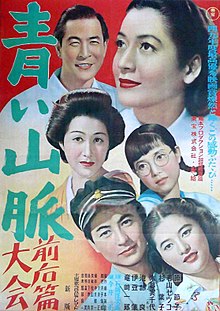Aoi sanmyaku (青い山脈, lit. Blue Mountain Range) is a 1949 black-and-white Japanese film directed by Tadashi Imai.[1][3] It is based on Yōjirō Ishizaka's novel of the same name, which was first published in serialised form in 1947.[4]
| Aoi sanmyaku | |
|---|---|
 Theatrical release poster | |
| Kanji | 青い山脈 |
| Revised Hepburn | Aoi Sanmyaku |
| Directed by | Tadashi Imai |
| Screenplay by |
|
| Based on | Blue Mountain Range by Yōjirō Ishizaka |
| Produced by | Sanezumi Fujimoto |
| Starring | |
| Cinematography | Asakazu Nakai |
| Music by | Ryoichi Hattori |
Production companies |
|
| Distributed by | Toho |
Release dates |
|
Running time | |
| Country | Japan |
| Language | Japanese |
Plot
editAfter defending Shinko, student at a rural girls' high school, for seeing a young man from the village, teacher Yukiko, who has just been transferred from Tokyo, finds herself in opposition to the conservative faculty and villagers.
Cast
edit| Actor | Role |
|---|---|
| Setsuko Hara | Yukiko Shimazaki |
| Ryō Ikebe | Rokusuke Kaneya |
| Michiyo Kogure | Umetaro/Tora Sasai |
| Yōko Sugi | Shinko Terazawa |
| Ichiro Ryuzaki | Tamao Numata |
| Setsuko Wakayama | Kazuko Sasai |
| Kamatari Fujiwara | Okamoto-san |
Production and legacy
editAoi sanmyaku was released in two parts, part one on July 19, 1949, part two one week later,[1][2][3] and was highly successful both with the audience and the critics.[5]
The film's popular theme song theme was sung by Ichiro Fujiyama and Mitsue Nara. Ishizaka's novel was adapted again in 1957, 1975 and 1988.[4]
Reception
editThe Japanese filmmaker Akira Kurosawa cited this movie as one of his 100 favorite films.[6]
References
edit- ^ a b c d "青い山脈 (Aoi Sanmyaku, Part one)". Japanese Movie Database (in Japanese). Retrieved 23 March 2021.
- ^ a b c "続青い山嶚 (Aoi Sanmyaku, Part two)". Japanese Movie Database (in Japanese). Retrieved 23 March 2021.
- ^ a b Galbraith IV, Stuart (2008). The Toho Studios Story: A History and Complete Filmography. Lanham, Toronto, Plymouth: Scarecrow Press. p. 72. ISBN 978-0-8108-6004-9.
- ^ a b "青い山脈 (Aoi sanmyaku)". Kotobank (in Japanese). Retrieved 23 March 2021.
- ^ Hirano, Kyoko (1992). Mr. Smith Goes to Tokyo: Japanese Cinema Under the American Occupation, 1945–1952. Washington and London: Smithsonian Institution Press. pp. 234–235. ISBN 1-56098-157-1.
- ^ Thomas-Mason, Lee. "From Stanley Kubrick to Martin Scorsese: Akira Kurosawa once named his top 100 favourite films of all time". Far Out Magazine. Retrieved 23 January 2023.
External links
edit- Aoi sanmyaku (Part one) at IMDb
- Aoi sanmyaku (Part two) at IMDb
- Aoi sanmyaku (Part one) at the Japanese Movie Database (in Japanese)
- Aoi sanmyaku (Part two) at the Japanese Movie Database (in Japanese)
- Scene from the film on YouTube